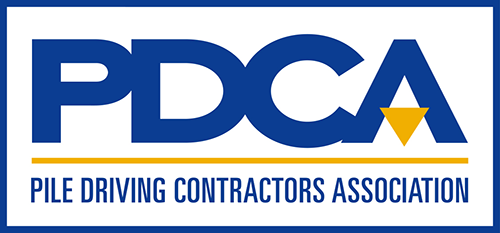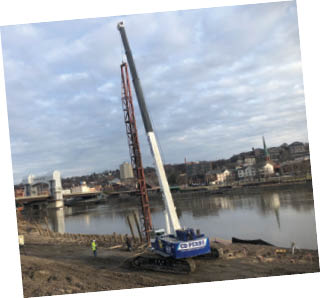 Congratulations to this year's Project of the Year Award winners! The PDCA Project of the Year Awards recognize companies that demonstrate ingenuity, hard work and commitment associated with their driven pile construction projects.
Thank you to all companies who took the time to submit an entry into the Project of the Year Awards. PDCA received a multitude of entries for the 2019 Project of the Year Awards and would like to thank the panel of volunteer judges, who grade each project by assigning a score in a variety of categories, such as innovation, cost savings and managing environmental considerations. All of the projects we received were deserving of an award, and our judges were presented with a very difficult task to determine the winners.
Start planning your entries into next year's awards program!
PDCA Associate or EngineeringAffiliate Member Category
Project Name: Permanent Canal Closures and Pumps Project
PDCA Engineering Affiliate Member: PND Engineers, Inc.
Read about this project on page 62.
Land: Less than $500,000
Project Name: Hudson River Seawall/Green Island Condo
Contractor: C.D. Perry
Read about this project on page 71.
Land: $500,000 to $2 Million
Project Name: Foundation Support for International Shipping Company
Contractor: GeoStructures, Inc.
Read about this project on page 75.
Land: $2 Million to $5 Million
Project Name: Valero Refining C5 Alkylation Project
Contractor: Cajun Industries, Inc.
Read about this project on page 78.
Land: Greater than $5 Million
Project Name: Salt Lake City International Airport Redevelopment
Contractor: Ralph L. Wadsworth Construction Co. LLC
Read about this project on page 82
Congratulations to this year's Project of the Year Award winners! The PDCA Project of the Year Awards recognize companies that demonstrate ingenuity, hard work and commitment associated with their driven pile construction projects.
Thank you to all companies who took the time to submit an entry into the Project of the Year Awards. PDCA received a multitude of entries for the 2019 Project of the Year Awards and would like to thank the panel of volunteer judges, who grade each project by assigning a score in a variety of categories, such as innovation, cost savings and managing environmental considerations. All of the projects we received were deserving of an award, and our judges were presented with a very difficult task to determine the winners.
Start planning your entries into next year's awards program!
PDCA Associate or EngineeringAffiliate Member Category
Project Name: Permanent Canal Closures and Pumps Project
PDCA Engineering Affiliate Member: PND Engineers, Inc.
Read about this project on page 62.
Land: Less than $500,000
Project Name: Hudson River Seawall/Green Island Condo
Contractor: C.D. Perry
Read about this project on page 71.
Land: $500,000 to $2 Million
Project Name: Foundation Support for International Shipping Company
Contractor: GeoStructures, Inc.
Read about this project on page 75.
Land: $2 Million to $5 Million
Project Name: Valero Refining C5 Alkylation Project
Contractor: Cajun Industries, Inc.
Read about this project on page 78.
Land: Greater than $5 Million
Project Name: Salt Lake City International Airport Redevelopment
Contractor: Ralph L. Wadsworth Construction Co. LLC
Read about this project on page 82PDCA Project of the Year Awards
August 28, 2019 Congratulations to this year's Project of the Year Award winners! The PDCA Project of the Year Awards recognize companies that demonstrate ingenuity, hard work and commitment associated with their driven pile construction projects.
Thank you to all companies who took the time to submit an entry into the Project of the Year Awards. PDCA received a multitude of entries for the 2019 Project of the Year Awards and would like to thank the panel of volunteer judges, who grade each project by assigning a score in a variety of categories, such as innovation, cost savings and managing environmental considerations. All of the projects we received were deserving of an award, and our judges were presented with a very difficult task to determine the winners.
Start planning your entries into next year's awards program!
PDCA Associate or EngineeringAffiliate Member Category
Project Name: Permanent Canal Closures and Pumps Project
PDCA Engineering Affiliate Member: PND Engineers, Inc.
Read about this project on page 62.
Land: Less than $500,000
Project Name: Hudson River Seawall/Green Island Condo
Contractor: C.D. Perry
Read about this project on page 71.
Land: $500,000 to $2 Million
Project Name: Foundation Support for International Shipping Company
Contractor: GeoStructures, Inc.
Read about this project on page 75.
Land: $2 Million to $5 Million
Project Name: Valero Refining C5 Alkylation Project
Contractor: Cajun Industries, Inc.
Read about this project on page 78.
Land: Greater than $5 Million
Project Name: Salt Lake City International Airport Redevelopment
Contractor: Ralph L. Wadsworth Construction Co. LLC
Read about this project on page 82
Congratulations to this year's Project of the Year Award winners! The PDCA Project of the Year Awards recognize companies that demonstrate ingenuity, hard work and commitment associated with their driven pile construction projects.
Thank you to all companies who took the time to submit an entry into the Project of the Year Awards. PDCA received a multitude of entries for the 2019 Project of the Year Awards and would like to thank the panel of volunteer judges, who grade each project by assigning a score in a variety of categories, such as innovation, cost savings and managing environmental considerations. All of the projects we received were deserving of an award, and our judges were presented with a very difficult task to determine the winners.
Start planning your entries into next year's awards program!
PDCA Associate or EngineeringAffiliate Member Category
Project Name: Permanent Canal Closures and Pumps Project
PDCA Engineering Affiliate Member: PND Engineers, Inc.
Read about this project on page 62.
Land: Less than $500,000
Project Name: Hudson River Seawall/Green Island Condo
Contractor: C.D. Perry
Read about this project on page 71.
Land: $500,000 to $2 Million
Project Name: Foundation Support for International Shipping Company
Contractor: GeoStructures, Inc.
Read about this project on page 75.
Land: $2 Million to $5 Million
Project Name: Valero Refining C5 Alkylation Project
Contractor: Cajun Industries, Inc.
Read about this project on page 78.
Land: Greater than $5 Million
Project Name: Salt Lake City International Airport Redevelopment
Contractor: Ralph L. Wadsworth Construction Co. LLC
Read about this project on page 82PDCA Associate Member of the Year Award
August 28, 2019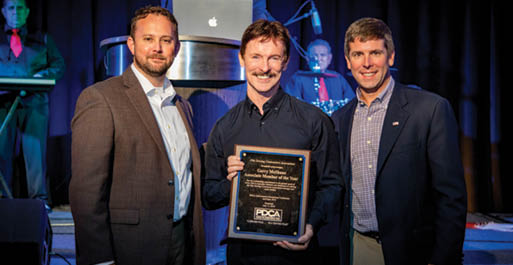 For the PDCA 22nd International Conference and Expo 2019, PDCA introduced a new award into the annual awards program. The PDCA Associate Member of the Year Award was created to acknowledge PDCA associate members who work toward the greater good of every other associate member and who strive to make the organization as a whole stronger and more unified.
The inaugural award was presented to Gerry McShane, the director of piling sales with Service Steel Warehouse, after multiple PDCA members nominated him to be the recipient. Service Steel, a PDCA associate member since 2014, is a structural and foundation steel distributor specializing in the distribution of steel from stock nationwide.
McShane's commitment to PDCA is obvious: he chairs both the PDCA Education Committee and the PDCA Steel Sheet Pile Committee. He and his fellow Education Committee members worked tirelessly to organize the PDCA 22nd International Conference and Expo 2019, resulting in an agenda packed with expert speakers and relevant topics. The Steel Sheet Pile Committee has spent countless hours updating outdated documents relating to steel sheet pile installation, corrosion and cost comparison. Those three documents the Steel Sheet Pile Installation Guide; the Steel Sheet Pile Corrosion Guide; and the Retaining Wall Cost Comparison Guide are now available through PDCA by visiting www.piledrivers.org.
McShane was not thinking about earning an award when he signed up for his various roles with PDCA.
"I was very surprised!" he said of receiving the award. "It was a great surprise."
"Gerry is absolutely deserving of this inaugural award and is a tremendous role model for members striving to follow in his footsteps," said Scott Callaway, PDCA president. "He's 'all in' with PDCA and I am extremely happy to see him be recognized for his commitments to this organization."
McShane attributes his active role in PDCA for some of Service Steel's success in the deep foundation construction market.
"The foundation sales distribution team [at Service Steel] involves engineering, sales and providing all the accessories that sheet piling demands, like fabrication, coating facilities, galvanizing, in addition to supplying a broad range of sheet piling, pipe piling and H-piling," said McShane. "[Being involved in PDCA] gives general exposure for the company. Service Steel is a relatively new company in the foundation sector, so getting exposure to the name and getting the community to know our people and service offering is a big asset."
McShane also has advice for other PDCA associate members who want to become more active participants in PDCA.
"I think they should be very involved in the committees," he said. "It's a great way to get familiar with PDCA's activities, it's a great way to get their name out there and it's a great way to be involved in an active community."
For the PDCA 22nd International Conference and Expo 2019, PDCA introduced a new award into the annual awards program. The PDCA Associate Member of the Year Award was created to acknowledge PDCA associate members who work toward the greater good of every other associate member and who strive to make the organization as a whole stronger and more unified.
The inaugural award was presented to Gerry McShane, the director of piling sales with Service Steel Warehouse, after multiple PDCA members nominated him to be the recipient. Service Steel, a PDCA associate member since 2014, is a structural and foundation steel distributor specializing in the distribution of steel from stock nationwide.
McShane's commitment to PDCA is obvious: he chairs both the PDCA Education Committee and the PDCA Steel Sheet Pile Committee. He and his fellow Education Committee members worked tirelessly to organize the PDCA 22nd International Conference and Expo 2019, resulting in an agenda packed with expert speakers and relevant topics. The Steel Sheet Pile Committee has spent countless hours updating outdated documents relating to steel sheet pile installation, corrosion and cost comparison. Those three documents the Steel Sheet Pile Installation Guide; the Steel Sheet Pile Corrosion Guide; and the Retaining Wall Cost Comparison Guide are now available through PDCA by visiting www.piledrivers.org.
McShane was not thinking about earning an award when he signed up for his various roles with PDCA.
"I was very surprised!" he said of receiving the award. "It was a great surprise."
"Gerry is absolutely deserving of this inaugural award and is a tremendous role model for members striving to follow in his footsteps," said Scott Callaway, PDCA president. "He's 'all in' with PDCA and I am extremely happy to see him be recognized for his commitments to this organization."
McShane attributes his active role in PDCA for some of Service Steel's success in the deep foundation construction market.
"The foundation sales distribution team [at Service Steel] involves engineering, sales and providing all the accessories that sheet piling demands, like fabrication, coating facilities, galvanizing, in addition to supplying a broad range of sheet piling, pipe piling and H-piling," said McShane. "[Being involved in PDCA] gives general exposure for the company. Service Steel is a relatively new company in the foundation sector, so getting exposure to the name and getting the community to know our people and service offering is a big asset."
McShane also has advice for other PDCA associate members who want to become more active participants in PDCA.
"I think they should be very involved in the committees," he said. "It's a great way to get familiar with PDCA's activities, it's a great way to get their name out there and it's a great way to be involved in an active community."John T. Parker, Jr. Industry Ambassador Award
August 28, 2019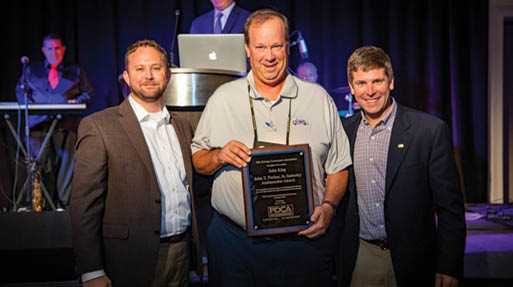 John T. Parker, Jr. of Parker Marine Contracting in Charleston, S.C., was, by the standards of anyone who knew him, an amazing person. Parker passed away at the age of 50 in January 2015.
Parker was an active member of the pile driving community for nearly three decades and his passing greatly affected members of the industry, especially in the South Carolina region. To honor his memory, PDCA created the John T. Parker, Jr. Industry Ambassador Award for a person who positively impacts the driven pile community through their own passion and promotion of driven piles.
At the PDCA 22nd Annual International Conference and Expo, the John T. Parker, Jr. Industry Ambassador Award was bestowed on John King of Pile Drivers, Inc., to resounding applause.
King is a well-known face at various PDCA events and an exuberant proponent of the driven pile. He was also a close personal friend of Parker's and was touched to win this award.
"I can't wait to show [John Parker's] wife," said King. "John Parker was a once-in-a-lifetime guy. He never met an enemy; he never said a bad word about anybody."
King highlights how much Parker cared for the employees of Parker Marine Contracting to emphasize the type of person he was.
"I've never met anyone who loved his employees more than he did," said King. "John could tell you the names of all of his employees' wives and children, and even knew where those children went to school. He knew so much about each individual employee. He was just a great ambassador for Parker Marine."
As much as Parker was an ambassador for his company, King has been an ambassador for the driven pile industry at large. He is a past-president of PDCA, the current president of the PDCA of South Carolina Chapter and an active member of several PDCA committees. For King, it all comes down to believing in the driven pile.
"I believe it's the best product on the market," said King. "Driven piles have very few flaws. People think we vibrate, but we don't. People say we're noisy, but we've worked on that with modern equipment. I'm always promoting piles. I think it's the best product for deep foundations, especially in [the South Carolina] market."
King is a proud supporter of the driven pile and of PDCA and commends the good work of his fellow members.
"There are so many members who deserve awards like this, but we'd be up there giving out awards for four hours," he said.
"I couldn't be happier to see John receive the John T. Parker, Jr. Industry Ambassador Award," said Jason Moore of Palmetto Pile Driving, Inc. in Charleston and the current PDCA vice president. "If it's possible to support the structure on a driven pile, John's going to ask the question. John believes in his product and he believes in the mission of PDCA. And John is going to make sure that you're aware of his product and PDCA to the benefit of all in the driven pile industry. All he asks is that we do the same. I can think of no stronger advocate for the driven pile!"
King offers advice to other PDCA members to support PDCA's cause: "Be dedicated to what you do and promote driven piles. And not even necessarily promote it, but don't hurt it. Don't go out there and try to make a quick buck and do it all."
John T. Parker, Jr. of Parker Marine Contracting in Charleston, S.C., was, by the standards of anyone who knew him, an amazing person. Parker passed away at the age of 50 in January 2015.
Parker was an active member of the pile driving community for nearly three decades and his passing greatly affected members of the industry, especially in the South Carolina region. To honor his memory, PDCA created the John T. Parker, Jr. Industry Ambassador Award for a person who positively impacts the driven pile community through their own passion and promotion of driven piles.
At the PDCA 22nd Annual International Conference and Expo, the John T. Parker, Jr. Industry Ambassador Award was bestowed on John King of Pile Drivers, Inc., to resounding applause.
King is a well-known face at various PDCA events and an exuberant proponent of the driven pile. He was also a close personal friend of Parker's and was touched to win this award.
"I can't wait to show [John Parker's] wife," said King. "John Parker was a once-in-a-lifetime guy. He never met an enemy; he never said a bad word about anybody."
King highlights how much Parker cared for the employees of Parker Marine Contracting to emphasize the type of person he was.
"I've never met anyone who loved his employees more than he did," said King. "John could tell you the names of all of his employees' wives and children, and even knew where those children went to school. He knew so much about each individual employee. He was just a great ambassador for Parker Marine."
As much as Parker was an ambassador for his company, King has been an ambassador for the driven pile industry at large. He is a past-president of PDCA, the current president of the PDCA of South Carolina Chapter and an active member of several PDCA committees. For King, it all comes down to believing in the driven pile.
"I believe it's the best product on the market," said King. "Driven piles have very few flaws. People think we vibrate, but we don't. People say we're noisy, but we've worked on that with modern equipment. I'm always promoting piles. I think it's the best product for deep foundations, especially in [the South Carolina] market."
King is a proud supporter of the driven pile and of PDCA and commends the good work of his fellow members.
"There are so many members who deserve awards like this, but we'd be up there giving out awards for four hours," he said.
"I couldn't be happier to see John receive the John T. Parker, Jr. Industry Ambassador Award," said Jason Moore of Palmetto Pile Driving, Inc. in Charleston and the current PDCA vice president. "If it's possible to support the structure on a driven pile, John's going to ask the question. John believes in his product and he believes in the mission of PDCA. And John is going to make sure that you're aware of his product and PDCA to the benefit of all in the driven pile industry. All he asks is that we do the same. I can think of no stronger advocate for the driven pile!"
King offers advice to other PDCA members to support PDCA's cause: "Be dedicated to what you do and promote driven piles. And not even necessarily promote it, but don't hurt it. Don't go out there and try to make a quick buck and do it all."PDCA Committee Chair of the Year Award
August 28, 2019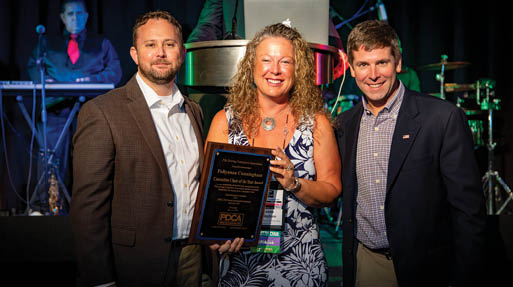 The various PDCA committees are comprised of volunteer members and are the lifeblood of the organization. Committee members and their respective chairs work diligently every year to accomplish a wealth of activities that promote and improve the driven pile industry. While all PDCA committees and committee chairs work tirelessly to give back to the entire membership, only one chairperson can be selected to hold the honor of PDCA Committee Chair of the Year. The recipient of this award, selected by the Board of Directors, is the person who shows dedication, commitment and exemplary leadership, not only to their committee and its tasks, but to all of those in the driven pile industry.
At the PDCA 22nd Annual International Conference and Expo, PDCA selected Pollyanna Cunningham with International Construction Equipment, Inc. to receive the Committee Chair of the Year Award for her tremendous efforts with the PDCA Communications Committee and dedication to PDCA, its members and its overall cause.
Cunningham has chaired the PDCA Communications Committee for 10 years, after having been asked in 2009 to step into the role. Despite her decade-long commitment, she was surprised to hear her name called for the award this year.
"I was completely shocked; I had nominated other folks to win!" she said. "I didn't expect it. I am grateful and excited, all rolled into one."
It's Cunningham's sheer enthusiasm for PDCA that made her the frontrunner for the Committee Chair of the Year award.
"For as long as I can recall at least for the last six years that I've been on the board and in an executive committee position Pollyanna has been consistently engaged," said Scott Callaway, president of PDCA. "Either as a committee chair or as a board member, her engagement has been unwavering. She's got a lot of energy and that shows in everything she does. Out of everybody in the entire organization, Pollyanna has been consistent in her engagement and her activity with PDCA, but especially as a committee chair."
The main function and focus of the PDCA Communications Committee is to plan and coordinate the content of PileDriver magazine, the monthly PDCA e-newsletter and www.piledrivers.org. In the past year, Cunningham has also spearheaded exciting new developments in PDCA's suite of communications, including revamping the association's website and launching the all-new PDCA mobile app.
"We took a look at the website and the PDCA app, and we did get the app launched and running," said Cunningham. "We're hopeful to begin working in different and new sectors to integrate all of this technology together."
Most PDCA members are very familiar with Cunningham and her quest for articles in PileDriver, proving how effective she is when it comes to managing and representing the Communications Committee.
"I love the fact that [representing the Communications Committee] gives me a window to see and talk to other people," she said. "With this role, I feel like it gives me almost a special mask; it gives me the confidence necessary to go out and start talking to people to find out what's going on in business and help them get their message out there."
Cunningham clearly holds a passion for PileDriver magazine and is eagerly anticipating the magazine's upcoming editions.
"We are getting really excited about the steel edition, which is Edition 5," she said. "And we're going to prove that steel and concrete work together and put a full edition together on those job stories for Edition 6. For Edition 1 [2020], we're going to bust out with a full concrete edition. But we won't forget about our friends in timber or anywhere else, and we have to get a new focus on all the equipment manufacturers. I really am looking forward to that."
The Communications Committee is actively seeking PDCA members to join and participate.
"We have fun," said Cunningham. "It's a great way to meet other PDCA members and really get networked and get to know people."
To join the PDCA Communications Committee or to request more information about any of PDCA's committees, phone the PDCA office at 904-215-4771.
The various PDCA committees are comprised of volunteer members and are the lifeblood of the organization. Committee members and their respective chairs work diligently every year to accomplish a wealth of activities that promote and improve the driven pile industry. While all PDCA committees and committee chairs work tirelessly to give back to the entire membership, only one chairperson can be selected to hold the honor of PDCA Committee Chair of the Year. The recipient of this award, selected by the Board of Directors, is the person who shows dedication, commitment and exemplary leadership, not only to their committee and its tasks, but to all of those in the driven pile industry.
At the PDCA 22nd Annual International Conference and Expo, PDCA selected Pollyanna Cunningham with International Construction Equipment, Inc. to receive the Committee Chair of the Year Award for her tremendous efforts with the PDCA Communications Committee and dedication to PDCA, its members and its overall cause.
Cunningham has chaired the PDCA Communications Committee for 10 years, after having been asked in 2009 to step into the role. Despite her decade-long commitment, she was surprised to hear her name called for the award this year.
"I was completely shocked; I had nominated other folks to win!" she said. "I didn't expect it. I am grateful and excited, all rolled into one."
It's Cunningham's sheer enthusiasm for PDCA that made her the frontrunner for the Committee Chair of the Year award.
"For as long as I can recall at least for the last six years that I've been on the board and in an executive committee position Pollyanna has been consistently engaged," said Scott Callaway, president of PDCA. "Either as a committee chair or as a board member, her engagement has been unwavering. She's got a lot of energy and that shows in everything she does. Out of everybody in the entire organization, Pollyanna has been consistent in her engagement and her activity with PDCA, but especially as a committee chair."
The main function and focus of the PDCA Communications Committee is to plan and coordinate the content of PileDriver magazine, the monthly PDCA e-newsletter and www.piledrivers.org. In the past year, Cunningham has also spearheaded exciting new developments in PDCA's suite of communications, including revamping the association's website and launching the all-new PDCA mobile app.
"We took a look at the website and the PDCA app, and we did get the app launched and running," said Cunningham. "We're hopeful to begin working in different and new sectors to integrate all of this technology together."
Most PDCA members are very familiar with Cunningham and her quest for articles in PileDriver, proving how effective she is when it comes to managing and representing the Communications Committee.
"I love the fact that [representing the Communications Committee] gives me a window to see and talk to other people," she said. "With this role, I feel like it gives me almost a special mask; it gives me the confidence necessary to go out and start talking to people to find out what's going on in business and help them get their message out there."
Cunningham clearly holds a passion for PileDriver magazine and is eagerly anticipating the magazine's upcoming editions.
"We are getting really excited about the steel edition, which is Edition 5," she said. "And we're going to prove that steel and concrete work together and put a full edition together on those job stories for Edition 6. For Edition 1 [2020], we're going to bust out with a full concrete edition. But we won't forget about our friends in timber or anywhere else, and we have to get a new focus on all the equipment manufacturers. I really am looking forward to that."
The Communications Committee is actively seeking PDCA members to join and participate.
"We have fun," said Cunningham. "It's a great way to meet other PDCA members and really get networked and get to know people."
To join the PDCA Communications Committee or to request more information about any of PDCA's committees, phone the PDCA office at 904-215-4771.Professional Engineer's Service Award
August 28, 2019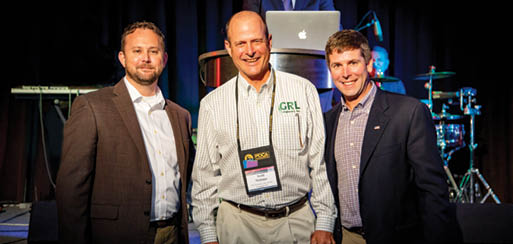 Each year, a panel of distinguished PDCA members is given the task to select one engineer who has made a significant contribution to the association, the driven pile industry and the engineering profession at large and bestow upon that person the Professional Engineer's Service Award. The recipient can represent the geotechnical, civil or structural engineering disciplines, and must have displayed exemplary leadership, technical innovation and practices that strengthen the engineering field of driven pile as it relates to deep foundations and earth retention systems throughout their career.
This year, the panel selected Scott Webster with GRL Engineers, Inc. to receive the Professional Engineer's Service Award. Webster is a geotechnical engineer who has worked with GRL Engineers, Inc. for nearly three decades he has managed the company's North Carolina office since the early '90s in addition to running GRL's offshore operations and is also the recently appointed treasurer on the PDCA Board of Directors.
"In his 27-plus years with GRL, Scott has been intimately involved with the driven pile industry," said Scott Callaway, president of PDCA. "He recently volunteered his time as a member of the PDCA Board of Directors and is now serving as treasurer on the Executive Committee."
"It was this unwavering commitment to PDCA along with his numerous professional contributions to the driven pile industry that we selected Scott to be this year's recipient of the Professional Engineer's Service Award," added Jason Moore, PDCA's vice president.
Despite Webster's tenure in the industry and active participation on the board, he wasn't expecting his name to be called for an award during PDCA's 22nd Annual International Conference and Expo.
"[I was] very surprised," he said. "I just didn't expect it. I'm honored and pleased."
GRL Engineers has long been a staunch supporter of PDCA, and Webster says that he is happy to be able to continue that legacy. He adds that he's been enjoying his involvement on the board.
"[Being a part of the board is] something I very much enjoy and it's something I look forward to," he said. "It's nice to meet all the people involved in our industry and make new friends."
What Webster enjoys most about working in the driven pile industry is being able to flex his problem-solving capabilities.
"I enjoy the variety of projects and variation of conditions and problems to tackle," he said. "The size of a project doesn't matter to [GRL] little jobs or big jobs they all have their own issues that need to be resolved."
It's that opportunity to overcome project challenges with creative solutions that Webster pinpoints as a critical reason that engineers need to be involved with PDCA.
"The biggest advantage of being active in PDCA is to find out what people are doing and what issues they're facing," he said. "You can find out information that will help you in the long run. You may not run across the problem someone is having [in the immediate future], but if you ever do, that information is there, it's available and it's helpful to you."
Each year, a panel of distinguished PDCA members is given the task to select one engineer who has made a significant contribution to the association, the driven pile industry and the engineering profession at large and bestow upon that person the Professional Engineer's Service Award. The recipient can represent the geotechnical, civil or structural engineering disciplines, and must have displayed exemplary leadership, technical innovation and practices that strengthen the engineering field of driven pile as it relates to deep foundations and earth retention systems throughout their career.
This year, the panel selected Scott Webster with GRL Engineers, Inc. to receive the Professional Engineer's Service Award. Webster is a geotechnical engineer who has worked with GRL Engineers, Inc. for nearly three decades he has managed the company's North Carolina office since the early '90s in addition to running GRL's offshore operations and is also the recently appointed treasurer on the PDCA Board of Directors.
"In his 27-plus years with GRL, Scott has been intimately involved with the driven pile industry," said Scott Callaway, president of PDCA. "He recently volunteered his time as a member of the PDCA Board of Directors and is now serving as treasurer on the Executive Committee."
"It was this unwavering commitment to PDCA along with his numerous professional contributions to the driven pile industry that we selected Scott to be this year's recipient of the Professional Engineer's Service Award," added Jason Moore, PDCA's vice president.
Despite Webster's tenure in the industry and active participation on the board, he wasn't expecting his name to be called for an award during PDCA's 22nd Annual International Conference and Expo.
"[I was] very surprised," he said. "I just didn't expect it. I'm honored and pleased."
GRL Engineers has long been a staunch supporter of PDCA, and Webster says that he is happy to be able to continue that legacy. He adds that he's been enjoying his involvement on the board.
"[Being a part of the board is] something I very much enjoy and it's something I look forward to," he said. "It's nice to meet all the people involved in our industry and make new friends."
What Webster enjoys most about working in the driven pile industry is being able to flex his problem-solving capabilities.
"I enjoy the variety of projects and variation of conditions and problems to tackle," he said. "The size of a project doesn't matter to [GRL] little jobs or big jobs they all have their own issues that need to be resolved."
It's that opportunity to overcome project challenges with creative solutions that Webster pinpoints as a critical reason that engineers need to be involved with PDCA.
"The biggest advantage of being active in PDCA is to find out what people are doing and what issues they're facing," he said. "You can find out information that will help you in the long run. You may not run across the problem someone is having [in the immediate future], but if you ever do, that information is there, it's available and it's helpful to you."Presidential Award for Distinguished Service
August 28, 2019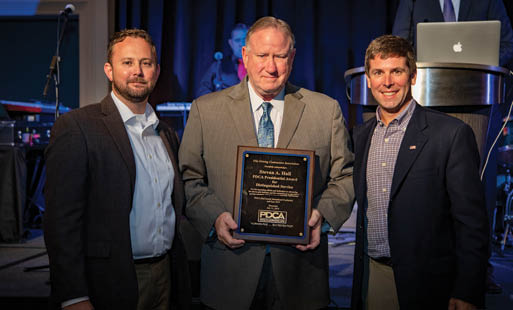 The Presidential Award for Distinguished Service is an annual award given to a person who has made significant, ongoing and long-term contributions to PDCA and the pile driving industry through effective leadership, support and participation. For 2019, the board unanimously had one person in mind as the clear winner.
Members of PDCA are undoubtedly familiar with Steve Hall; for nearly 14 years, Hall has represented PDCA as its executive director, and has done so with dedication, passion and unwavering belief in the driven pile.
Hall retired from his role at PDCA in February. To honor his contributions to the association and industry at large, at the PDCA 22nd Annual International Conference and Expo, association president Scott Callaway presented Hall with the Presidential Award for Distinguished Service.
"I was very, very surprised [to hear my name called for the award]," said Hall.
Regardless of his surprise, the board could not think of anyone better suited to receive the award this year.
"Steve Hall received the Presidential Award for Distinguished Service because of his dedication and commitment to PDCA throughout his 14 years as executive director," said Callaway. "He has been a true leader and a believer in the driven pile industry to the better of us all."
Hall says that when he originally proposed the idea for the Presidential Award for Distinguished Service to the board in 2008, the intention was to recognize members who demonstrated a strong commitment to PDCA in a volunteer capacity.
"It was so unexpected on my part because I'm not a member," said Hall. "I had a job to do and I wanted to do that job to the best of my abilities. There are a lot of people deserving of this award. I never expected that I would be selected [or that I was even being considered to win]. I guess the best way to describe it is honored."
When Callaway, current PDCA executive director Frank Peters and vice president Jason Moore announced Hall as this year's award recipient at the dinner reception during the annual conference, Hall was visibly moved and received a standing ovation from the crowd of PDCA members. Hall was so overwhelmed that he almost didn't register what was happening.
"When they called my name, to me the award is so special that it evoked a bit of an emotional response from me," said Hall. "By the time I got up to the front, I had tears in my eyes. I think I probably noticed everyone standing up but because it was such an emotional experience, my vision was pretty narrow. The whole night was totally overwhelming."
Based on the reaction of the crowd, Hall has much to be proud of regarding his career with PDCA.
"Speaking generally, [I'm most proud of] the growth of PDCA from the time I began as executive director to the time that I retired," he said. "And equally as important, the elevation of the stature of PDCA within the industry. I think that we became more viable, we were looked at by others in the industry and government as a significant contributor to the progressiveness of driven pile. I'm proud of that. I'm proud of the fact that we made some tremendous strides in just about every aspect of PDCA. That wasn't always easy to accomplish."
As much as he enjoyed his time in the PDCA office, Hall knew that it was time for him to retire.
"There comes a time when you should retire, and you'll know when that is," he said. "I knew that my time to retire from PDCA was when I left in February. I can say that I'm enjoying it thoroughly."
Hall has plans to travel with his wife, Cathy, using the travel fund raised by PDCA members as a retirement gift, and has been staying busy with various volunteer opportunities, such as getting involved with a no-kill animal shelter as well as the Wounded Warriors program. He also completed a photography course at the University of North Florida and already has several camping trips under his belt.
Above all, when he reflects on his career, Hall hopes that PDCA members have benefitted in some way through his role with the organization.
"I always said to the people who worked with me is that the PDCA members are the ones that pay our salaries and we have to be cognizant of that," said Hall. "We have to do our very best jobs [for them]. I hope I did that well and that the people I represented through PDCA felt like they were represented as best they could be.
"I hope that people, when they find their place in this world, that the satisfaction they get in their jobs is like the satisfaction that I got working with PDCA. It was such an opportunity and a pleasure to work with such a dedicated group of members."
The Presidential Award for Distinguished Service is an annual award given to a person who has made significant, ongoing and long-term contributions to PDCA and the pile driving industry through effective leadership, support and participation. For 2019, the board unanimously had one person in mind as the clear winner.
Members of PDCA are undoubtedly familiar with Steve Hall; for nearly 14 years, Hall has represented PDCA as its executive director, and has done so with dedication, passion and unwavering belief in the driven pile.
Hall retired from his role at PDCA in February. To honor his contributions to the association and industry at large, at the PDCA 22nd Annual International Conference and Expo, association president Scott Callaway presented Hall with the Presidential Award for Distinguished Service.
"I was very, very surprised [to hear my name called for the award]," said Hall.
Regardless of his surprise, the board could not think of anyone better suited to receive the award this year.
"Steve Hall received the Presidential Award for Distinguished Service because of his dedication and commitment to PDCA throughout his 14 years as executive director," said Callaway. "He has been a true leader and a believer in the driven pile industry to the better of us all."
Hall says that when he originally proposed the idea for the Presidential Award for Distinguished Service to the board in 2008, the intention was to recognize members who demonstrated a strong commitment to PDCA in a volunteer capacity.
"It was so unexpected on my part because I'm not a member," said Hall. "I had a job to do and I wanted to do that job to the best of my abilities. There are a lot of people deserving of this award. I never expected that I would be selected [or that I was even being considered to win]. I guess the best way to describe it is honored."
When Callaway, current PDCA executive director Frank Peters and vice president Jason Moore announced Hall as this year's award recipient at the dinner reception during the annual conference, Hall was visibly moved and received a standing ovation from the crowd of PDCA members. Hall was so overwhelmed that he almost didn't register what was happening.
"When they called my name, to me the award is so special that it evoked a bit of an emotional response from me," said Hall. "By the time I got up to the front, I had tears in my eyes. I think I probably noticed everyone standing up but because it was such an emotional experience, my vision was pretty narrow. The whole night was totally overwhelming."
Based on the reaction of the crowd, Hall has much to be proud of regarding his career with PDCA.
"Speaking generally, [I'm most proud of] the growth of PDCA from the time I began as executive director to the time that I retired," he said. "And equally as important, the elevation of the stature of PDCA within the industry. I think that we became more viable, we were looked at by others in the industry and government as a significant contributor to the progressiveness of driven pile. I'm proud of that. I'm proud of the fact that we made some tremendous strides in just about every aspect of PDCA. That wasn't always easy to accomplish."
As much as he enjoyed his time in the PDCA office, Hall knew that it was time for him to retire.
"There comes a time when you should retire, and you'll know when that is," he said. "I knew that my time to retire from PDCA was when I left in February. I can say that I'm enjoying it thoroughly."
Hall has plans to travel with his wife, Cathy, using the travel fund raised by PDCA members as a retirement gift, and has been staying busy with various volunteer opportunities, such as getting involved with a no-kill animal shelter as well as the Wounded Warriors program. He also completed a photography course at the University of North Florida and already has several camping trips under his belt.
Above all, when he reflects on his career, Hall hopes that PDCA members have benefitted in some way through his role with the organization.
"I always said to the people who worked with me is that the PDCA members are the ones that pay our salaries and we have to be cognizant of that," said Hall. "We have to do our very best jobs [for them]. I hope I did that well and that the people I represented through PDCA felt like they were represented as best they could be.
"I hope that people, when they find their place in this world, that the satisfaction they get in their jobs is like the satisfaction that I got working with PDCA. It was such an opportunity and a pleasure to work with such a dedicated group of members."Thank you to our sponsors
August 28, 2019Marquis SponsorInternational Construction Equipment ICE® Tech Out
Silver SponsorInternational Construction Equipment ICE® Hotel Guest Room Key Cards
Silver SponsorInternational Construction Equipment ICE® Exhibit Hall Registration-Arrival Bag
Silver SponsorInternational Construction Equipment ICE® Exhibit Breakfasts
PDCA 22nd Annual InternationalConference & Expo 2019
August 28, 2019 The PDCA 22nd Annual International Conference & Expo has come to an end, and what an exciting few days it was!
More than 250 driven pile professionals gathered at the Four Seasons Resort Orlando Walt Disney World® Resort in Orlando, Fla., from July 9 to 12. Delegates enjoyed in-person committee meetings, a lively trade show hall, relevant educational presentations, PDCA awards programs and much, much more. PDCA also debuted the PDCA Store, full of merchandise for members to show off their association pride and help accomplish an item from the 2019 strategic plan: increase PDCA's visibility.
PDCA extends its sincerest appreciation to all who supported, attended and participated in this year's annual event. The PDCA Education Committee worked diligently to put together an excellent program for the week, and those efforts proved successful.
Congratulations to all individuals and companies who took home PDCA awards, and PDCA was honored to be able to officially celebrate Steve Hall in his retirement at this year's annual reception.
The PDCA staff hopes to see you again at the 23rd Annual International Conference and Expo 2020, taking place at the Arizona Grand Resort in Phoenix, Ariz., May 6 to 9, 2020.
The PDCA 22nd Annual International Conference & Expo has come to an end, and what an exciting few days it was!
More than 250 driven pile professionals gathered at the Four Seasons Resort Orlando Walt Disney World® Resort in Orlando, Fla., from July 9 to 12. Delegates enjoyed in-person committee meetings, a lively trade show hall, relevant educational presentations, PDCA awards programs and much, much more. PDCA also debuted the PDCA Store, full of merchandise for members to show off their association pride and help accomplish an item from the 2019 strategic plan: increase PDCA's visibility.
PDCA extends its sincerest appreciation to all who supported, attended and participated in this year's annual event. The PDCA Education Committee worked diligently to put together an excellent program for the week, and those efforts proved successful.
Congratulations to all individuals and companies who took home PDCA awards, and PDCA was honored to be able to officially celebrate Steve Hall in his retirement at this year's annual reception.
The PDCA staff hopes to see you again at the 23rd Annual International Conference and Expo 2020, taking place at the Arizona Grand Resort in Phoenix, Ariz., May 6 to 9, 2020.PDCA of the Northeast Chapter Sporting Clay Shoot
August 28, 2019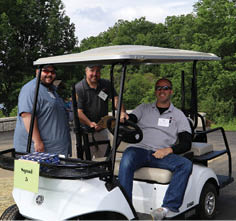 Sporting shooters from New Jersey, New York, Pennsylvania and beyond gathered June 14th for the 5th Annual PDCA Northeast Chapter Sporting Clay Shoot at Lehigh Valley Sporting Clays in Coplay, Pa. The popular event attracted 75 PDCA members and their guests. Groups of four shooters rotated through several shooting stations positioned throughout the sprawling and often challenging course. Following the action in the field, the participants retreated to the facility's banquet hall for awards and a luncheon. Some winners of the Sporting Clay Shoot contests included Brian Jecker of Dewberry Engineers, who was named Best Male shooter; Diane Jecker of Dewberry Engineers who was Best Female shooter; and Theresa Engler of the Deep Foundations Institute, who was crowned Worst Shooter.
The PDCA Northeast Chapter thanks all participants for their support of the Scholarship Fund, and the following sponsors who made the annual event possible:
International Construction Equipment Event Sponsor
R. Kremer & Son Marine Contractors, LLC Cigar Sponsor
Linde-Griffith Construction Company Lunch Sponsor
Shooting Station Sponsors:
CZM US
ECA
George Harms Construction Company
Hammer & Steel, Inc.
Hoffman Equipment Company
International Construction Equipment
John B. Wright Agency
Junttan
Linde-Griffith Construciton Company
NUCOR Skyline
R. Kremer & Son Marine Contractors, LLC
Weeks Marine
Sporting shooters from New Jersey, New York, Pennsylvania and beyond gathered June 14th for the 5th Annual PDCA Northeast Chapter Sporting Clay Shoot at Lehigh Valley Sporting Clays in Coplay, Pa. The popular event attracted 75 PDCA members and their guests. Groups of four shooters rotated through several shooting stations positioned throughout the sprawling and often challenging course. Following the action in the field, the participants retreated to the facility's banquet hall for awards and a luncheon. Some winners of the Sporting Clay Shoot contests included Brian Jecker of Dewberry Engineers, who was named Best Male shooter; Diane Jecker of Dewberry Engineers who was Best Female shooter; and Theresa Engler of the Deep Foundations Institute, who was crowned Worst Shooter.
The PDCA Northeast Chapter thanks all participants for their support of the Scholarship Fund, and the following sponsors who made the annual event possible:
International Construction Equipment Event Sponsor
R. Kremer & Son Marine Contractors, LLC Cigar Sponsor
Linde-Griffith Construction Company Lunch Sponsor
Shooting Station Sponsors:
CZM US
ECA
George Harms Construction Company
Hammer & Steel, Inc.
Hoffman Equipment Company
International Construction Equipment
John B. Wright Agency
Junttan
Linde-Griffith Construciton Company
NUCOR Skyline
R. Kremer & Son Marine Contractors, LLC
Weeks MarineIndustry News
August 28, 2019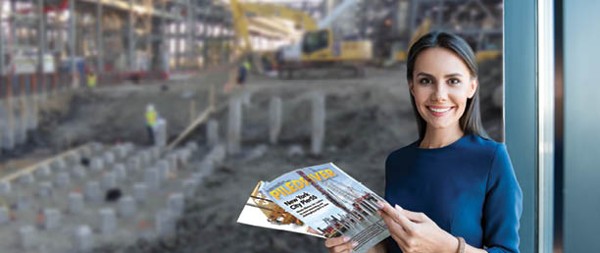 Meever USA expands southeastern U.S. salesforce
Exciting things are happening at Meever USA.
"2019 has been a growth year for Meever USA," said Jeroen Koelewijn, president of Meever USA. "We have added new people, product lines and services. Meever USA has expanded its southeastern USA salesforce with the additions of Sarah Honeyman and Dawn Kieffer, who bring more than 31 years' experience to the operation."
Honeyman has been appointed southeast territory sales manager and Dawn Kieffer is now the southeast territory rental manager.
Meever USA will be opening a southeastern U.S. service facility in the Jacksonville, Fla. area to stock and support rentals and sales of new and used steel sheet pile, including reconditioning and fabrication. The new location will allow Meever USA to expedite deliveries, and provide more accurate and personal service to all of its southeast USA customers.
In addition, Meever USA is pleased to announce its association with Steel Piling USA. Steel Piling USA is a new facility dedicated to manufacturing domestic steel sheet pile, domestic spiral weld pipe and heavy wide flange beams in Erie, Mich. Steel Piling USA was established in 2018. This is a unique joint venture between American, Chinese and European specialists in the global deep foundation industry. The new manufacturer offers years of international and domestic professional experience in all aspects of the steel piling industry.
Meever USA has developed and is distributing a new and unique "bracing system." The bracing system can be custom-designed, providing safe, efficient, economical solutions for all size trenching and cofferdam projects.
Recent appointments at Steel Piling USA include Roderick Olds as Midwest territory sales manager and Paul Jaquillard as West Coast territory sales manager.
Morris-Shea completes deep foundation for Ascend Apartments Birmingham high-rise
Morris-Shea, a geotechnical contractor headquartered in Irondale, Ala., has completed installation of driven H-piles for the deep foundation of the new Ascend Apartments in downtown Birmingham. The 17-story residential building's mixed-use design includes 198 student occupancy units, ground floor retail space, a second story parking garage and a rooftop swimming pool. Morris-Shea installed 261 high-capacity H-piles as a value engineered alternate to the original specification for drilled shafts with rock sockets. The original foundation design raised budget concerns that impacted the project's feasibility.
The Morris-Shea team completed H-pile load testing and production pile installation in only 20 workdays. Subsurface conditions varied considerably from pile-to-pile with dolomite rock pinnacles and crevices requiring piles be driven to depths as shallow as 40 feet and as deep as 120 feet. Morris-Shea installed high-capacity 12-inch by 74-foot H-piles with a 200-ton working load, rather than typical 12-inch by 53-foot H-piles with a smaller 50-ton load. The high-capacity piles were driven in 60-foot lengths to rock refusal with a PVE 50 rig using a five-ton hydraulic hammer. The contractor performed a static load test to 400 tons prior to commencing installation to verify load capacity.
The Ascend Apartments jobsite sits atop the Knox Group Formation, a subsurface mineral deposit dominated by Copper Ridge dolomite. The H-piles are installed through residual clays to refusal at the dolomite bedrock. The depth of the piles is highly varied due to cavities and fracturing commonly found in this type of subsurface.
Motocut moves to a new location
MotoCut Ltd. is growing and moving to new larger premises to better serve its customers. The company has been at its current location since 2012, but due to recent growth, will relocate to Menotie 1, Ylöjärvi in Finland.
The new, larger facility will provide more production space, which is scalable, and an improved meeting and training environment with plenty of free parking. The location in Ylöjärvi next to city of Tampere is within easy reach less than two hours by train from Helsinki and even more conveniently accessible by air, thanks to Tampere's flight connections. Tampere is located in southern Finland, some 170 km northwest of Helsinki, capital of the Finland.
MotoCut's new address is:
MotoCut Ltd.Menotie 133470 YlöjärviFinland
ECA names service managers in U.S. and Canada
Equipment Corporation of America (ECA), a distributor of specialty foundation equipment, has named several service managers at its branches in the United States and Canada.
Chris McCune has been promoted to service manager at ECA Pittsburgh after working as a service technician at the branch since 2016. McCune's goal is to mentor younger employees and current technicians to help them follow the same successful path he followed.
Peter Kassaris has been promoted to service manager at ECA Canada Company. Through hard work and dedication, he was promoted to the senior technician role within 15 months of being hired. Kassaris had already amassed eight years of experience in the foundation construction industry when he came to ECA Canada in September 2017. He aims to build the best service department in the Canadian foundation construction industry.
Trey Carver has been promoted to service manager at ECA Florida. He began his career in 2006 as an equipment technician at Pile Equipment. Carver joined the team as a technician when ECA purchased the Florida-based company in 2015. He worked his way up from technician to foreman, and in four short years, was promoted to service manager of ECA Jacksonville in February 2019. Carver strives to maintain strong customer relations through professionalism and exceptional customer service, and aspires to build a strong, self-sufficient service department capable of handling any potential issue ECA's customers might encounter.
Kevin "Buddy" Austin began his career in 2006 as a drilling rig operator in the foundation construction industry and has since been promoted to service manager at ECA Washington. He joined ECA in 2011 as a service technician and quickly advanced into ECA Washington's lead technician role. Austin's motivation, professionalism and dedication to both customers and fellow employees resulted in his promotion to service manager. His 13 years of experience, focused on building and maintaining relationships with ECA's customers and vendors, will help ensure the future of the company and its employees.
Rich Weinstein joined ECA Philadelphia as service manager in April 2019. He came to ECA with 17 years of experience in operations, service, parts and warranty management. With his comprehensive experience, Weinstein aims for the service team to be even more responsive, resulting in less machine downtime and a better overall experience with ECA. He also plans to spend more time in the field and visiting customers to develop a deeper understanding of their needs.
Derek Brodnax joins Service Steel Warehouse
Derek Brodnax has joined the Service Steel Structural and Foundations steel sales team.
Brodnax has a business background obtained at the Stephen F. Austin State University. He combines this with a wealth of industry experience from over 10 years with STI and in structural sales with Service Steel.
In addition to sales and project management, Brodnax has had extensive training in CAD, galvanizing, quality assurance, purchasing, developing reports, project plans and scheduling. He is also proficient in reviewing bid proposals and preparing competitive bid solutions.
Brodnax will be responsible for developing all foundations steel solution sales in the southern states of the U.S., particularly Texas, Louisiana, Mississippi and Alabama.
Reach out to Derek via email at dbrodnax@servicesteel.org or phone him at 713-675-2631.
Migratory bird evaluations by ECS Limited
With bird nesting season in full swing, the Mid-Atlantic Environmental team at ECS Limited has been providing dozens of migratory bird evaluations in short succession. Due to the high volume and rapid turnaround time required for these surveys, the group doing the surveys was the "Bird Rapid Response Team (BRRT)."
Most birds in North America are protected under several environmental conservation acts, such as the Migratory Bird Treaty Act, Federal Endangered Species Act, Bald and Golden Eagle Protection Act, as well as state regulations. The ECS team supports clients by providing guidance on complying with these regulations and helping avoid impacts to these species through the design and building process.
If a client is working on a project that requires migratory bird and other protected species monitoring and finds a bird nesting in the area, they would need support. ECS goes to the site, finds the nest, identifis the bird species, notes if the nest is active and determines where the birds are in their breeding season. If the nest is active, ECS advises clients as to what sort of work they may be able to perform and estimate when the nest would be declared inactive. ECS can also perform stress monitoring for birds during construction activities, even if the nest is not located on an artificial structure.
The BRRT can travel anywhere in the United States and mobilize to produce a deliverable within days for clients in order to minimize the disruption to their project.
ECS can also perform these services for animals that not are birds, including turtles, marine mammals (seals, dolphins, whales, etc.) for in-water work and more.
Meever USA expands southeastern U.S. salesforce
Exciting things are happening at Meever USA.
"2019 has been a growth year for Meever USA," said Jeroen Koelewijn, president of Meever USA. "We have added new people, product lines and services. Meever USA has expanded its southeastern USA salesforce with the additions of Sarah Honeyman and Dawn Kieffer, who bring more than 31 years' experience to the operation."
Honeyman has been appointed southeast territory sales manager and Dawn Kieffer is now the southeast territory rental manager.
Meever USA will be opening a southeastern U.S. service facility in the Jacksonville, Fla. area to stock and support rentals and sales of new and used steel sheet pile, including reconditioning and fabrication. The new location will allow Meever USA to expedite deliveries, and provide more accurate and personal service to all of its southeast USA customers.
In addition, Meever USA is pleased to announce its association with Steel Piling USA. Steel Piling USA is a new facility dedicated to manufacturing domestic steel sheet pile, domestic spiral weld pipe and heavy wide flange beams in Erie, Mich. Steel Piling USA was established in 2018. This is a unique joint venture between American, Chinese and European specialists in the global deep foundation industry. The new manufacturer offers years of international and domestic professional experience in all aspects of the steel piling industry.
Meever USA has developed and is distributing a new and unique "bracing system." The bracing system can be custom-designed, providing safe, efficient, economical solutions for all size trenching and cofferdam projects.
Recent appointments at Steel Piling USA include Roderick Olds as Midwest territory sales manager and Paul Jaquillard as West Coast territory sales manager.
Morris-Shea completes deep foundation for Ascend Apartments Birmingham high-rise
Morris-Shea, a geotechnical contractor headquartered in Irondale, Ala., has completed installation of driven H-piles for the deep foundation of the new Ascend Apartments in downtown Birmingham. The 17-story residential building's mixed-use design includes 198 student occupancy units, ground floor retail space, a second story parking garage and a rooftop swimming pool. Morris-Shea installed 261 high-capacity H-piles as a value engineered alternate to the original specification for drilled shafts with rock sockets. The original foundation design raised budget concerns that impacted the project's feasibility.
The Morris-Shea team completed H-pile load testing and production pile installation in only 20 workdays. Subsurface conditions varied considerably from pile-to-pile with dolomite rock pinnacles and crevices requiring piles be driven to depths as shallow as 40 feet and as deep as 120 feet. Morris-Shea installed high-capacity 12-inch by 74-foot H-piles with a 200-ton working load, rather than typical 12-inch by 53-foot H-piles with a smaller 50-ton load. The high-capacity piles were driven in 60-foot lengths to rock refusal with a PVE 50 rig using a five-ton hydraulic hammer. The contractor performed a static load test to 400 tons prior to commencing installation to verify load capacity.
The Ascend Apartments jobsite sits atop the Knox Group Formation, a subsurface mineral deposit dominated by Copper Ridge dolomite. The H-piles are installed through residual clays to refusal at the dolomite bedrock. The depth of the piles is highly varied due to cavities and fracturing commonly found in this type of subsurface.
Motocut moves to a new location
MotoCut Ltd. is growing and moving to new larger premises to better serve its customers. The company has been at its current location since 2012, but due to recent growth, will relocate to Menotie 1, Ylöjärvi in Finland.
The new, larger facility will provide more production space, which is scalable, and an improved meeting and training environment with plenty of free parking. The location in Ylöjärvi next to city of Tampere is within easy reach less than two hours by train from Helsinki and even more conveniently accessible by air, thanks to Tampere's flight connections. Tampere is located in southern Finland, some 170 km northwest of Helsinki, capital of the Finland.
MotoCut's new address is:
MotoCut Ltd.Menotie 133470 YlöjärviFinland
ECA names service managers in U.S. and Canada
Equipment Corporation of America (ECA), a distributor of specialty foundation equipment, has named several service managers at its branches in the United States and Canada.
Chris McCune has been promoted to service manager at ECA Pittsburgh after working as a service technician at the branch since 2016. McCune's goal is to mentor younger employees and current technicians to help them follow the same successful path he followed.
Peter Kassaris has been promoted to service manager at ECA Canada Company. Through hard work and dedication, he was promoted to the senior technician role within 15 months of being hired. Kassaris had already amassed eight years of experience in the foundation construction industry when he came to ECA Canada in September 2017. He aims to build the best service department in the Canadian foundation construction industry.
Trey Carver has been promoted to service manager at ECA Florida. He began his career in 2006 as an equipment technician at Pile Equipment. Carver joined the team as a technician when ECA purchased the Florida-based company in 2015. He worked his way up from technician to foreman, and in four short years, was promoted to service manager of ECA Jacksonville in February 2019. Carver strives to maintain strong customer relations through professionalism and exceptional customer service, and aspires to build a strong, self-sufficient service department capable of handling any potential issue ECA's customers might encounter.
Kevin "Buddy" Austin began his career in 2006 as a drilling rig operator in the foundation construction industry and has since been promoted to service manager at ECA Washington. He joined ECA in 2011 as a service technician and quickly advanced into ECA Washington's lead technician role. Austin's motivation, professionalism and dedication to both customers and fellow employees resulted in his promotion to service manager. His 13 years of experience, focused on building and maintaining relationships with ECA's customers and vendors, will help ensure the future of the company and its employees.
Rich Weinstein joined ECA Philadelphia as service manager in April 2019. He came to ECA with 17 years of experience in operations, service, parts and warranty management. With his comprehensive experience, Weinstein aims for the service team to be even more responsive, resulting in less machine downtime and a better overall experience with ECA. He also plans to spend more time in the field and visiting customers to develop a deeper understanding of their needs.
Derek Brodnax joins Service Steel Warehouse
Derek Brodnax has joined the Service Steel Structural and Foundations steel sales team.
Brodnax has a business background obtained at the Stephen F. Austin State University. He combines this with a wealth of industry experience from over 10 years with STI and in structural sales with Service Steel.
In addition to sales and project management, Brodnax has had extensive training in CAD, galvanizing, quality assurance, purchasing, developing reports, project plans and scheduling. He is also proficient in reviewing bid proposals and preparing competitive bid solutions.
Brodnax will be responsible for developing all foundations steel solution sales in the southern states of the U.S., particularly Texas, Louisiana, Mississippi and Alabama.
Reach out to Derek via email at dbrodnax@servicesteel.org or phone him at 713-675-2631.
Migratory bird evaluations by ECS Limited
With bird nesting season in full swing, the Mid-Atlantic Environmental team at ECS Limited has been providing dozens of migratory bird evaluations in short succession. Due to the high volume and rapid turnaround time required for these surveys, the group doing the surveys was the "Bird Rapid Response Team (BRRT)."
Most birds in North America are protected under several environmental conservation acts, such as the Migratory Bird Treaty Act, Federal Endangered Species Act, Bald and Golden Eagle Protection Act, as well as state regulations. The ECS team supports clients by providing guidance on complying with these regulations and helping avoid impacts to these species through the design and building process.
If a client is working on a project that requires migratory bird and other protected species monitoring and finds a bird nesting in the area, they would need support. ECS goes to the site, finds the nest, identifis the bird species, notes if the nest is active and determines where the birds are in their breeding season. If the nest is active, ECS advises clients as to what sort of work they may be able to perform and estimate when the nest would be declared inactive. ECS can also perform stress monitoring for birds during construction activities, even if the nest is not located on an artificial structure.
The BRRT can travel anywhere in the United States and mobilize to produce a deliverable within days for clients in order to minimize the disruption to their project.
ECS can also perform these services for animals that not are birds, including turtles, marine mammals (seals, dolphins, whales, etc.) for in-water work and more.

